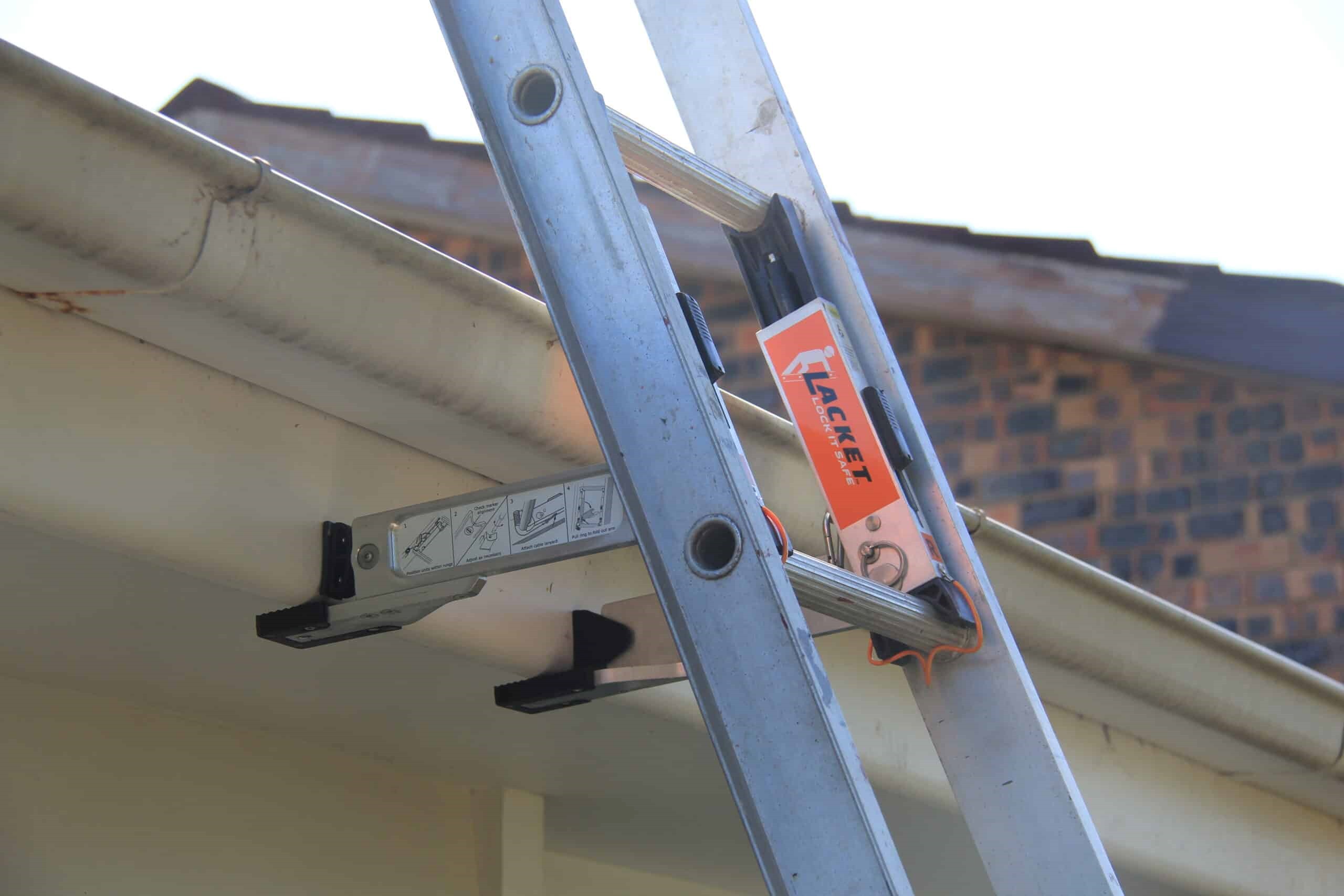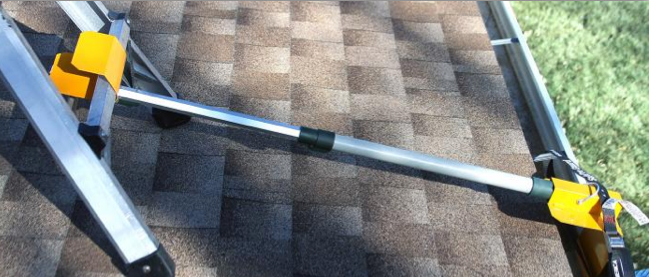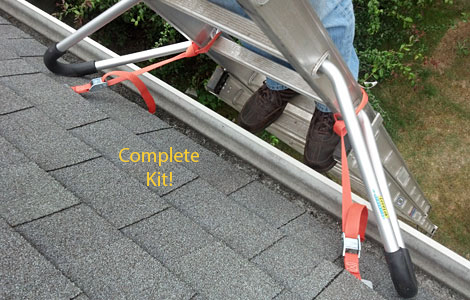To secure a ladder to a roof, use ladder stabilizers or standoff arms for stability and anchor the ladder securely. Ensuring the ladder is properly secured to the roof will prevent any accidents or injuries.
When working at heights, it is crucial to prioritize safety and take necessary precautions. By following proper ladder safety protocols and securing the ladder correctly, you can work confidently and safely on the roof. We will discuss various methods and tips on how to securely attach a ladder to a roof to ensure a safe and efficient working environment.
Let’s dive into the details to make sure you have the right knowledge to safely secure a ladder to a roof for your next project.
Assessing Roof And Ladder
Securing a ladder to the roof requires careful assessment to ensure safety. Follow these steps to properly secure a ladder, reducing the risk of accidents.
Selecting The Right Ladder
When it comes to securing a ladder to the roof, one of the most crucial steps is selecting the right ladder. Not all ladders are suitable for roof work. You need a ladder that is long enough to reach the roof edge securely without overextending yourself or the ladder.
Examining The Roof Surface
Before climbing up with your ladder, it’s essential to examine the roof surface to ensure it can support both your weight and the ladder’s weight. A weak or damaged roof can be hazardous and potentially lead to accidents or injuries. Here are a few steps to follow when examining the roof surface:
Step 1: Inspect for Damage
Walk around the perimeter of the roof and visually inspect for any signs of damage, such as loose or missing shingles, cracks, or sagging areas. Ensure that the roof structure is in good condition and can support the weight of a ladder.
Step 2: Look for a Stable Surface
Identify a stable surface on the roof where you can place the top end of the ladder. Look for areas that are free from debris, moss, or other slippery materials that may cause instability. A stable surface will provide a secure base for the ladder.
Step 3: Check for Slopes and Angles
Pay attention to the slope or angle of the roof. If your ladder is not equipped for such angles, it may be unsafe to use it on that particular roof. Make sure to check the ladder’s specifications for the maximum angle it can safely handle.
Step 4: Consider Additional Support
In some cases, it may be necessary to use additional support devices, such as ladder stabilizers or roof hooks, to secure the ladder more firmly to the roof surface. These accessories can provide an extra level of stability and prevent the ladder from shifting or slipping while in use.
Conclusion
Assessing both the roof and ladder is a critical step in securing a ladder to the roof. By selecting the right ladder and examining the roof surface, you can ensure a safer working environment and minimize the risk of accidents or injuries.

Credit: storables.com
Choosing The Appropriate Anchoring Method
Securing a ladder to a roof is essential for safety and stability during any climbing task. Choosing the right anchoring method is crucial to ensure a secure connection.
Using Roof Hooks
Rope hooks with a curved design are suitable for attaching ladders to roofs with a gutter on the edge. The hook should securely grip the roof without causing damage.
Using Ridge Hooks
Ridge hooks are ideal for pitched roofs with a ridge in the middle. Ensure the ridge hook fits securely over the ridge to prevent the ladder from sliding or slipping.
Using Roof Brackets
Roof brackets provide sturdy support by clamping the ladder to the roof’s surface. Make sure the brackets are properly installed and tightened to avoid any accidents.
Securing The Ladder
When it comes to securing the ladder, it’s crucial to follow proper safety measures to prevent accidents.
Positioning The Ladder Correctly
Place the ladder on a level surface and extend it 3 feet above the roof edge for stability.
Ensure the ladder is at a safe angle of 75 degrees to prevent it from slipping.
Tying Off The Ladder
Use a ladder stabilizing device or tie the ladder off at the top to a secure anchor point.
Never allow the ladder to lean against the gutter or unsupported roof eaves.
Using Stabilizers
Consider using ladder stabilizers to provide additional support and prevent lateral movement.
Ensure stabilizers are securely attached and that the ladder remains stable during use.
Testing The Stability
To secure a ladder to a roof safely, testing the stability is crucial. Ensure the ladder base is secure and angled properly against the roof. Use ladder stabilizers or standoff brackets for added safety and always have a spotter for assistance.
Testing the stability of a ladder secured to a roof is absolutely crucial to ensure the safety of anyone using it. By properly assessing the ladder’s stability, you can minimize the risk of accidents and create a safe environment for carrying out tasks on the roof. In this section, we will explore the key factors to consider when testing the stability of a ladder to the roof.Checking The Security Of Anchor Points
One of the most important steps in testing ladder stability is checking the security of the anchor points. Without strong anchor points, the ladder could easily shift or slip, resulting in a dangerous situation. Here’s a step-by-step guide to assess the security of your ladder’s anchor points:1. Inspect the Roof Surface
Start by visually inspecting the roof surface where you plan to place the ladder. Ensure there are no loose tiles, debris, or any other obstacles that could compromise the stability of the ladder. Clear away any hazards before proceeding.2. Verify Stable Attachment
Next, examine the attachment points of the ladder, such as hooks or brackets. Ensure they are securely fastened and provide a stable connection to the roof. If you notice any loose or damaged attachments, repair or replace them before proceeding.Ensuring Proper Weight Distribution
Apart from checking the security of anchor points, it’s also crucial to ensure proper weight distribution on the ladder. Uneven weight distribution can lead to imbalance and increase the likelihood of accidents. Follow these steps to ensure proper weight distribution:1. Center Ladder Placement
When positioning the ladder on the roof, make sure it is centered to distribute weight evenly on both sides. Placing the ladder off-center can cause one side to become overloaded and potentially result in the ladder tipping over.2. Avoid Overload
Ensure that the ladder is not overloaded with excessive weight. Before ascending, consider the weight of yourself and any tools or equipment you’ll be carrying. Be mindful of the ladder’s weight capacity and adhere to it to maintain stability and safety.Conclusion
Testing the stability of a ladder secured to the roof is a critical step in ensuring the safety of anyone using it. By thoroughly checking the security of anchor points and ensuring proper weight distribution, you can minimize the risk of accidents and create a secure environment for tasks on the roof. Remember to follow these guidelines meticulously to maintain a stable ladder and enhance overall safety.Safety Precautions
When it comes to working on the roof, safety should always be the top priority. Follow these essential safety precautions to ensure a secure and accident-free experience.
Wearing Personal Protective Equipment
Personal protective equipment (PPE) is vital when working at heights. Ensure you wear a sturdy safety helmet, non-slip footwear, and grippy work gloves to minimize the risk of falls and injuries. It’s crucial to have a harness and lanyard to prevent accidents.
Assessing Weather Conditions
Prior to setting up the ladder, it’s important to assess the current weather conditions. Avoid working during windy or rainy conditions as this can significantly increase the risk of accidents. An unfavorable weather forecast is a clear indication to postpone the roof-related work.

Credit: roofingmagazine.com
Aftercare And Maintenance
Aftercare and Maintenance are crucial aspects of securing a ladder to a roof. Proper maintenance ensures the ladder remains in good condition and can be used safely for future tasks. It also helps prevent accidents and prolongs the lifespan of the ladder.
Removing The Ladder Safely
When it’s time to remove the ladder from the roof, it’s essential to do so with caution to avoid accidents. Start by firmly grasping the ladder while ensuring no one is standing below it. Slowly descend the ladder and make sure each step is securely planted on the ground before releasing your grip.
Storing And Inspecting The Ladder
Proper storage of the ladder is vital to maintain its integrity. Store the ladder in a dry, well-ventilated area away from extreme temperatures and moisture. Regularly inspect the ladder for any signs of damage, such as cracks, loose bolts, or bent rungs. Additionally, check the ladder’s stability before each use to ensure it’s safe for climbing.

Credit: m.youtube.com
Frequently Asked Questions Of How To Secure Ladder To Roof
How Do I Secure A Ladder To The Roof?
To secure a ladder to the roof, use a ladder hook or standoff stabilizer. Ensure the ladder is on a stable surface, with someone holding the base for extra security. Always follow safety guidelines and regulations for ladder use.
What Type Of Ladder Is Best For Roof Access?
For roof access, an extension ladder is typically recommended. Ensure it’s long enough to safely reach the roof, and has non-slip feet. Always check the weight capacity and any specific requirements for your specific roof type.
Can I Use Bungee Cords To Secure A Ladder To The Roof?
Bungee cords are not recommended for securing a ladder to the roof, as they may not provide sufficient stability. It’s safer to use purpose-built ladder accessories, such as ladder hooks or stabilizers, for a secure and stable setup.
Conclusion
Securing a ladder to the roof is crucial for safety and efficiency. By following these simple steps, such as choosing the right ladder, using proper attachments, and ensuring a solid anchor point, you can prevent accidents and work with confidence.
Remember, safety should always be the top priority, so take the time to secure your ladder properly before starting any roofing project. By doing so, you can ensure a successful and incident-free working experience. Stay safe and happy climbing!
{ “@context”: “https://schema.org”, “@type”: “FAQPage”, “mainEntity”: [ { “@type”: “Question”, “name”: “How do I secure a ladder to the roof?”, “acceptedAnswer”: { “@type”: “Answer”, “text”: “To secure a ladder to the roof, use a ladder hook or standoff stabilizer. Ensure the ladder is on a stable surface, with someone holding the base for extra security. Always follow safety guidelines and regulations for ladder use.” } } , { “@type”: “Question”, “name”: “What type of ladder is best for roof access?”, “acceptedAnswer”: { “@type”: “Answer”, “text”: “For roof access, an extension ladder is typically recommended. Ensure it’s long enough to safely reach the roof, and has non-slip feet. Always check the weight capacity and any specific requirements for your specific roof type.” } } , { “@type”: “Question”, “name”: “Can I use bungee cords to secure a ladder to the roof?”, “acceptedAnswer”: { “@type”: “Answer”, “text”: “Bungee cords are not recommended for securing a ladder to the roof, as they may not provide sufficient stability. It’s safer to use purpose-built ladder accessories, such as ladder hooks or stabilizers, for a secure and stable setup.” } } ] }
